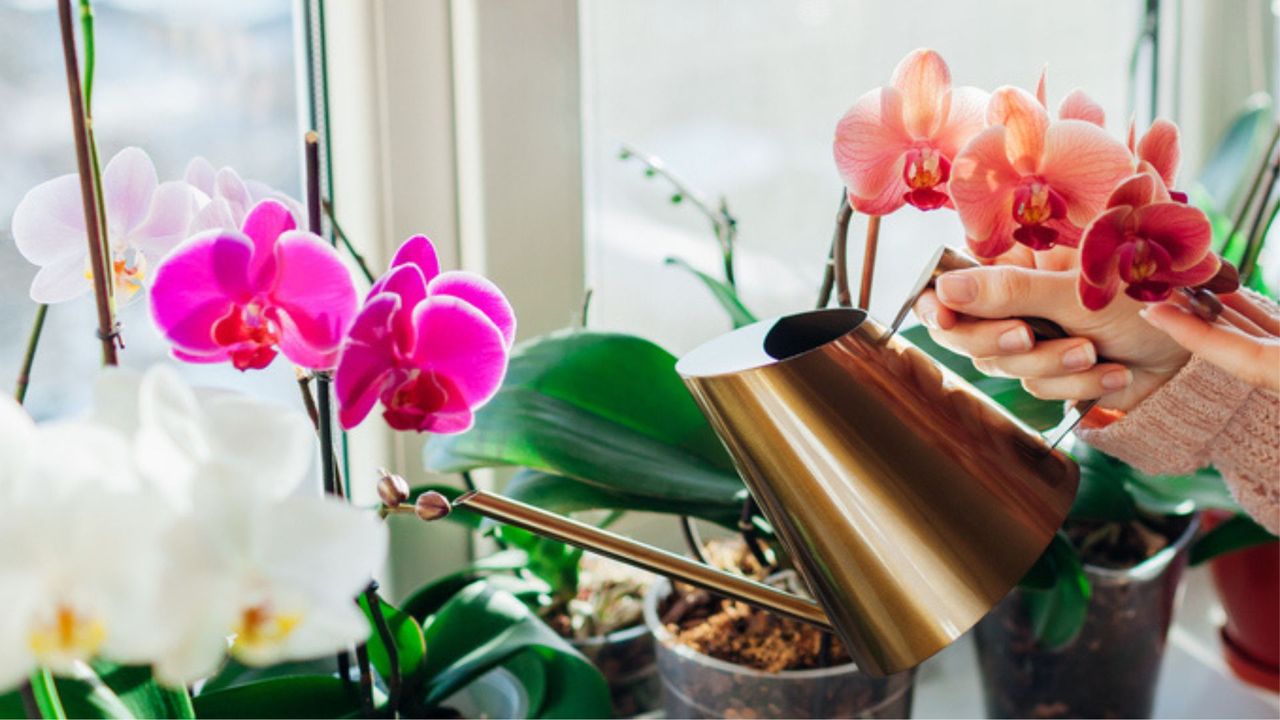Top 10 Questions About Orchids


Here at Gardening Know How we get lots of questions, and our goal is to provide answers to those inquiries to the best of our knowledge. Orchids are popular flowers, but for newcomers, growing them can be intimidating. The following information includes the 10 most commonly asked questions about growing orchids.
Orchids are not as difficult to care for as some people fear; they are just different from other houseplants. As epiphytes, their roots need air circulation and moisture. Use an orchid growing medium instead of soil and replant with new medium as needed. The medium will break down with time, so keep an eye on it. Water your orchid plant about once a week by soaking the roots in the sink. Use a fertilizer once weekly as well. Place an orchid in a sunny spot and keep the air around it humid by setting the pot on a tray of pebbles filled with water.
2. How much do I water an orchid?
Most orchid plants need to be watered once a week. When the growing medium is dry for about an inch down or lower, the plant needs watering. When watering, really soak the roots. Put the container in the sink and let water run over and soak the roots several times.
3. What type of pot or container should you plant an orchid in?
The most important factor in choosing a container for orchids is drainage. The roots need to be wet most of the time but not sitting in water, so a pot with drainage holes is an absolute must. Any kind of material is fine, but the best type of pot for an orchid is clear or translucent plastic. In the wild, orchids grow with their roots exposed to air and light, so this allows some light to get through to them.
Gardening tips, videos, info and more delivered right to your inbox!
Sign up for the Gardening Know How newsletter today and receive a free copy of our e-book "How to Grow Delicious Tomatoes".
4. How to fertilize my orchid?
Orchids need water soluble fertilizer because they don't grow in soil. A balanced fertilizer or one designed specifically for orchids will work. Use fertilizer at least once a month but up to once weekly. Mix the fertilizer with water as described on the package instructions and use it to water the plant by soaking the roots.
5. Should you cut the stem off the plant when it's done blooming?
When cutting back orchids, it really depends on the type, as they have various needs. For Phalaenopsis orchids, trim off flowers as they begin to fade using sharp shears. Cut back to the main branch. When it is completely done blooming, typically in the fall, trim back the stem that held the flowers to about an inch from the main stem. With a Dendrobium orchid, you can cut back flowers as they fade, but leave the flowering stem in place. New flowers will bloom on it later.
6. Why do the buds form but then fall without opening, and how can I get my orchid to bloom?
When an orchid drops its buds before blooming, it is called bud blast. Buds are very sensitive and if you experience this, it is likely the environmental conditions are not right and are impacting them. Some causes include: too little light or too much direct light; dry air; extreme temperatures, such as cold drafts from a window; over- or under-watering; air pollutants; insect infestations; and too much fertilizer. Check your conditions and make adjustments to get the orchid to bloom.
7. My orchid has mealybugs. How do I get rid of them?
Pests on orchid plants can be frustrating but easily remedied in most cases. Mealybugs are immobile and will grow covers over themselves on the leaves of orchids. Gently scrape these off to begin, and then use a gentle pesticide to treat your plant until the pest is completely gone. Use neem oil in warm water or an insecticidal soap once a week.
8. Should you trim the orchid roots that are growing out of the pot?
Orchids often grow new roots that emerge from the container; these are called tendrils or air roots. As epiphytes, it is natural for orchids to have roots exposed to the air. They absorb moisture and nutrients from the air. Healthy tendrils are firm and whitish in color. These should not be removed. They are healthy and normal. Dry, dead, or diseased tendrils can be removed with a clean, sharp tool.
9. What type of soil or growing medium is good for an orchid?
Orchids should never be planted in soil. They are epiphytes, which means they grow with their roots exposed and attached to trees. The roots absorb nutrients from the air and from decaying matter on the trees. In containers they should be grown in specialized medium or mix made just for orchids. There are different types of mix depending on the variety of orchid. Common materials in mixes include tree bark, peat moss, perlite, lava rock, tree fern, and sphagnum moss.
10. When and how to repot orchids?
There are two reasons to repot an orchid: when the roots start growing outside the container and when the growing medium has broken down too much. The latter causes the medium to become denser, preventing roots from getting needed airflow. Depending on the orchid and its growing conditions, it may need to be repotted as often as every six months or as little as every three years. Use a slightly larger pot, brand new medium, and move the orchid when it is not flowering. Clean and soak the roots before putting in the new pot.
We all have questions now and then, whether long-time gardeners or those just starting out. So if you have a gardening question, get a gardening answer. We're always here to help.

Mary Ellen Ellis has been gardening for over 20 years. With degrees in Chemistry and Biology, Mary Ellen's specialties are flowers, native plants, and herbs.
-
 Ideal Azalea Water Requirements – For Lush, Healthy Shrubs That Will Thrive For Years
Ideal Azalea Water Requirements – For Lush, Healthy Shrubs That Will Thrive For YearsWhat are an azalea's water requirements? Learn how to keep these beautiful spring-blooming shrubs happy and healthy in your yard or container garden.
By Amy Grant
-
 7 Vegetables To Plant In April: Start Indoors Or Outside For A Bumper Summer Harvest
7 Vegetables To Plant In April: Start Indoors Or Outside For A Bumper Summer HarvestAchieve your growing ambitions with these best vegetables to plant in April – including cold-hardy crops to sow direct and tender varieties to start indoors
By Mary Ellen Ellis